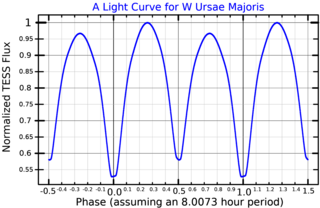
W Ursae Majoris is the variable star designation for a binary star system in the northern constellation of Ursa Major. It has an apparent visual magnitude of about 7.9, which is too faint to be seen with the naked eye. However, it can be viewed with a small telescope. Parallax measurements place it at a distance of roughly 169 light years (52 parsecs) from Earth.

UW Canis Majoris is a star in the constellation Canis Major. It is classified as a Beta Lyrae eclipsing contact binary and given the variable star designation UW Canis Majoris. Its brightness varies from magnitude +4.84 to +5.33 with a period of 4.39 days. Bode had initially labelled it as Tau2 Canis Majoris, but this designation had been dropped by Gould and subsequent authors.

S Antliae is a W Ursae Majoris-type eclipsing binary star in Antlia.

Epsilon Coronae Australis, is a star system located in the constellation Corona Australis. Varying in brightness between apparent magnitudes of 4.74 to 5 over 14 hours, it is the brightest W Ursae Majoris variable in the night sky.
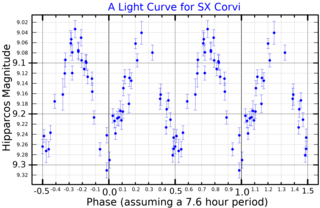
SX Corvi is an eclipsing binary star system in the constellation Corvus, ranging from apparent magnitude 8.99 to 9.25 over 7.6 hours. The system is a contact binary also known as a W Ursae Majoris variable, where the two component stars orbit closely enough to each other for mass to have been transferred between them—in this case the secondary having transferred a large amount of mass to the primary.

RR Centauri is a variable star of apparent magnitude maximum +7.29. It is located in the constellation of Centaurus, approximately 320 light years distant from the solar system.
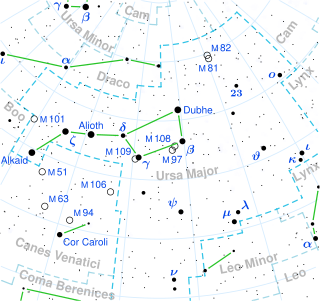
65 Ursae Majoris, abbreviated as 65 UMa, is a star system in the constellation of Ursa Major. With a combined apparent magnitude of about 6.5, it is at the limit of human eyesight and is just barely visible to the naked eye in ideal conditions. It is about 760 light years away from Earth.
Phi Phoenicis, Latinized from φ Phoenicis, is a binary star system in the southern constellation of Phoenix. It is faintly visible to the naked eye with an apparent visual magnitude of 5.1. Based upon an annual parallax shift of 10.185 mas as seen from Earth, it is located approximately 320 light years from the Sun. It is moving away with a heliocentric radial velocity of 10.4 km/s.

AD Phoenicis is a variable star in the constellation of Phoenix. An eclipsing binary, its apparent magnitude has a maximum of 10.27, dimming to 10.80 during primary and secondary eclipses, which are approximately equal. From parallax measurements by the Gaia spacecraft, the system is located at a distance of 655 light-years from Earth.
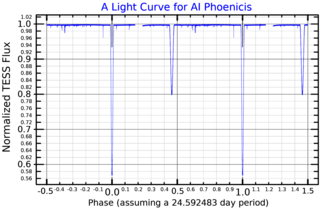
AI Phoenicis is a variable star in the constellation of Phoenix. An Algol-type eclipsing binary, its apparent magnitude is constant at 8.58 for most of the time, sharply dropping to 9.35 during primary eclipse and to 8.89 during secondary eclipse. The system's variability was discovered by W. Strohmeier in 1972. From parallax measurements by the Gaia spacecraft, the system is located at a distance of 560 light-years from Earth, in agreement with earlier estimates based on its luminosity.

V752 Centauri is multiple star system and variable star in the constellation of Centaurus. An eclipsing binary, its apparent magnitude has a maximum of 9.10, dimming to 9.66 during primary eclipse and 9.61 during secondary eclipse. Its variability was discovered by Howard Bond in 1970. From parallax measurements by the Gaia spacecraft, the system is located at a distance of 410 light-years from Earth.

TX Ursae Majoris is an eclipsing binary star system in the northern circumpolar constellation of Ursa Major. With a combined apparent visual magnitude of 6.97, the system is too faint to be readily viewed with the naked eye. The pair orbit each other with a period of 3.063 days in a circular orbit, with their orbital plane aligned close to the line of sight from the Earth. During the primary eclipse, the net brightness decreases by 1.74 magnitudes, while the secondary eclipse results in a drop of just 0.07 magnitude. TX UMa is located at a distance of approximately 780 light years from the Sun based on parallax measurements, but is drifting closer with a mean radial velocity of −13 km/s.

UX Ursae Majoris is an Algol type binary star system in the northern circumpolar constellation of Ursa Major. It is classified as a nova-like variable star similar to DQ Herculis, although no eruptions have been reported. Since its discovery in 1933, this system has been the subject of numerous studies attempting to determine its properties. The combined apparent visual magnitude of UX UMa ranges from 12.57 down to 14.15. The system is located at a distance of approximately 952 light years from the Sun based on parallax, and is drifting further away with a radial velocity of 112 km/s.

XY Ursae Majoris is a short period binary star system in the northern circumpolar constellation of Ursa Major. It is an eclipsing binary with a baseline apparent visual magnitude of 9.50. The system is located at a distance of 221.5 light years from the Sun based on parallax measurements, but is drifting closer with a radial velocity of −10 km/s. It has a relatively high proper motion, traversing the celestial sphere at the angular rate of 0.191″·yr−1.

EQ Tauri is a triple star system in the equatorial constellation of Taurus that includes a contact eclipsing binary. The system is too faint to be viewed with the naked eye, having a baseline apparent visual magnitude of 10.5. During the primary eclipse, the brightness of the system drops to magnitude 11.03, then to 10.97 during the secondary minimum. The secondary eclipse is total. Based on parallax measurements, it is located at a distance of approximately 730 light years from the Sun.

AG Virginis is an eclipsing binary star system in the equatorial constellation of Virgo. With a maximum apparent visual magnitude of 8.51 it is too faint to be visible to the naked eye. The system is located at a distance of approximately 820 light years from the Sun based on parallax measurements.

AH Virginis is a contact binary star system in the equatorial constellation of Virgo, abbreviated AH Vir. It is a variable star with a brightness that peaks at an apparent visual magnitude of 9.18, making it too faint to be viewed with the naked eye. The distance to this system is approximately 338 light years based on parallax measurements, and it is drifting further away with a mean radial velocity of 7 km/s. O. J. Eggen in 1969 included this system as a probable member of the Wolf 630 group of co-moving stars.

VV Ursae Majoris is a binary star system in the northern circumpolar constellation of Ursa Major, abbreviated VV UMa. It is a variable star system with a brightness that cycles around an apparent visual magnitude of 10.19, making it too faint to be visible to the naked eye. The system is located at a distance of approximately 1,500 light years based on parallax measurements.
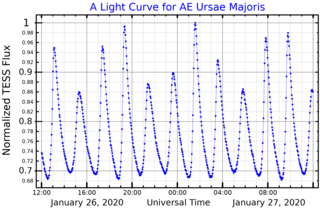
AE Ursae Majoris is a star in the northern circumpolar constellation of Ursa Major, abbreviated AE UMa. It is a variable star that ranges in brightness from a peak apparent visual magnitude of 10.86 down to 11.52. The distance to this star is approximately 2,400 light years based on parallax measurements.

AW Ursae Majoris is a binary star system in the northern circumpolar constellation of Ursa Major, abbreviated AW UMa. It is an A-type W Ursae Majoris variable with an apparent visual magnitude of 6.83, which is near the lower limit of visibility to the naked eye. This is an eclipsing binary with the brightness dropping to magnitude 7.13 during the primary eclipse and to 7.08 with the secondary eclipse. Parallax measurements give a distance estimate of 221 light years from the Sun. It is drifting closer to the Sun with a radial velocity of approximately −17 km/s. The system has a high proper motion, traversing the celestial sphere at the rate of 0.216 arc second per annum.



















